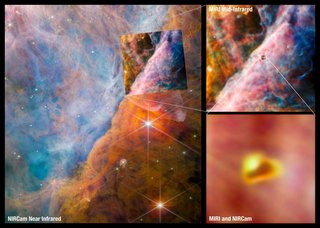The James Webb Space Telescope has discovered the hydrocarbon molecule CH3+ in a newly emerging solar and planetary system 1,500 light years away. CH3+ is an elementary hydrocarbon molecule that does not react with the ubiquitous hydrogen (H2), but reacts with other molecules and can thus contribute to the formation of much more complex molecules in space.
Since the 1970s, CH3+ has been predicted in space. Now it could also be proven empirically on the basis of its spectral ‘fingerprint’ in the infrared range. Observations show that CH3+ is formed in the Orion Nebula of our galaxy due to the strong UV radiation of neighbouring suns. Work carried out by researchers at the University of Cologne, in particular laboratory measurements of the spectral fingerprint, also contributed to the result. The discovery was published in the journal Nature under the title ‘Detection of the Methyl Cation Formed by UV Driven Gas-Phase Organic Chemistry’.
This discovery has far-reaching implications for understanding chemistry and the formation of molecules in space. These findings especially provide new information on the details of how our own solar system formed.
Through modern astronomy, we know that molecules, such as carbon dioxide (CO2) and water (H2O), are produced in large numbers in space. Each of these molecules has an individual spectrum, similar to a unique human fingerprint. Once the spectroscopic ‘fingerprint’ of a molecule has been taken in the laboratory, it can also be discovered in space – from regions such as our Milky Way to distant galaxies. These characteristic fingerprints are usually in the range of radio or heat radiation (infrared range), and can be observed with specific telescopes.
Among the molecules, hydrocarbons (molecules consisting of carbon - C - and hydrogen - H) play a special role because they can, among other things, act as precursors of biomolecules. Biomolecules are organic substances that form the basis of living organisms. CH3+ is an elementary hydrocarbon molecule and a building block of more complex molecules. Up to now, CH3+ could not be detected in space because it does not emit radio radiation, but only infrared radiation due to its symmetrical triangular structure. So far, no infrared telescope was capable of capturing this radiation.
The launch of the James Webb Space Telescope (JWST), which measures in the infrared range, and its first light in the summer of 2022 have now made this discovery – and many others – possible. The JWST is considered to be the successor to the equally ground-breaking Hubble Space Telescope. The resolution (spatial as well as spectroscopic) and high sensitivity of the new telescope, especially at long wavelengths, opens up new, unique observation possibilities.
Various groups at the UoC’s Institute for Astrophysics have contributed to the current research results, also through the construction of some JWST spectrometer components (Working Group Professor Dr Andreas Eckart). Another team, the Cologne Submillimetre Astrophysics Group, has been studying the physics and chemistry of the Orion Nebula for a long time. The observations with the JWST were co-designed and evaluated by Privatdozent Dr Markus Röllig and Dr Yoko Okada.
Experiments conducted by the Laboratory Astrophysics & Spectroscopy Group (Working Group Professor Dr Stephan Schlemmer) made it possible to identify CH3+. The group deals with molecular spectroscopy, in which it measures the spectral fingerprints of molecules in the laboratory in the radio and infrared range, which are necessary for identification in space. The CH3+ molecule was already examined in a so-called cold ion trap in 2018 under the leadership of Professor Schlemmer and Privatdozent Dr Oskar Asvany. In the experiment, several thousand CH3+ ions were trapped and irradiated with an infrared laser. The exact spectral position of the infrared fingerprints of this molecule, which the JWST has now observed, could be determined. Oskar Asvany remarked: “It is good to see that the data on CH3+, which was gained five years ago and which until now has not unfolded its full impact, have become so important as a result of the JWST data.” Stephan Schlemmer added: “This encourages us and other groups around the world to investigate this particular molecule even more closely in the future.”
Media contact:
Professor Dr Stephan Schlemmer
Institute for Astrophysics
+49 221 470 7880
schlemmerph1.uni-koeln.de
Press and Communications Team:
Jan Voelkel
+49 221 470 2356
j.voelkelverw.uni-koeln.de
More information:
https://esawebb.org/news/weic2315/
